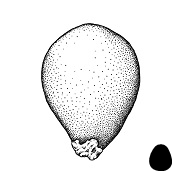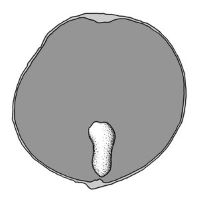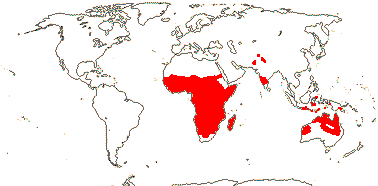Family Name: Pedaliaceae R. Brown
Synonym(s): Sesamaceae Horan.; Trapellaceae Honda & Sakis.
Common Name(s): sesame family
*Number of genera/species: 13/75
List of genera records in GRIN-Global
Fruit a capsulecapsule:
a dry, dehiscent fruit derived from a compound ovary , usually loculicidalloculicidal:
, usually loculicidalloculicidal:
type of capsular dehiscence, opening longitudinally through the locules (compare septicidal)
 (tardily), sometimes indehiscentindehiscent:
(tardily), sometimes indehiscentindehiscent:
not opening on its own, as in a fruit
 , 6–60 mm long, globoseglobose:
, 6–60 mm long, globoseglobose:
3D shape—more or less spherical to angularangular:
to angularangular:
2D shape—having sides that meet at acute or obtuse angles
, often laterally compressedcompressed:
flattened; in grasses, used to denote compression (not necessarily flattened) either laterally or dorsiventrally
and circularcircular:
(of embryo) linear embryo is curved into an "O" shape or elliptical, tereteterete:
or elliptical, tereteterete:
approximately circular in cross section; width and thickness approximately equal
 or lenticularlenticular:
or lenticularlenticular:
3D shape—lens-shaped; biconvex in transection, short or long beakedbeak:
in transection, short or long beakedbeak:
a usually firm, terminal appendage, sometimes tapered (Pterodiscus spp., Sesamum spp.), sometimes with narrow or broad wings, pergamentaceous or rigid, sometimes also bearing recurved hookswith hooks:
(Pterodiscus spp., Sesamum spp.), sometimes with narrow or broad wings, pergamentaceous or rigid, sometimes also bearing recurved hookswith hooks:
bristles or spines with curved or backwards pointing tips, or with secondary bristles along their length . Fruits with 2–60 seeds. Pericarppericarp:
. Fruits with 2–60 seeds. Pericarppericarp:
fruit wall or fruit coat
brown, dulldull:
reflecting only a low proportion of incident light, with no apparent sheen , woodywoody:
, woodywoody:
texture—consisting mainly of indurate lignified tissues, characteristic of or resembling wood
or coriaceouscoriaceous:
texture—leathery
, glabrousglabrous:
without hairs
or pubescentpubescent:
surface relief—bearing hairs
, with emergences, such as spines, apicalapical:
at or pertaining to the end of the seed or fruit distal from its point of attachment (i.e., base)
horns, recurved hookswith hooks:
bristles or spines with curved or backwards pointing tips, or with secondary bristles along their length , or tubercles, sometimes smooth (Sesamothamnus, Sesamum). Emergences form from endocarpendocarp:
, or tubercles, sometimes smooth (Sesamothamnus, Sesamum). Emergences form from endocarpendocarp:
the inner layer of the pericarp, if divided into layers with epicarpepicarp:
with epicarpepicarp:
outer layer of fruit wall or pericarp, if divided into layers; note here used synonymously with exocarp becoming a thin layer at maturity.
becoming a thin layer at maturity.
Seeds obovateobovate:
2D shape—ovate or egg-shaped in outline, with attachment at or near the narrow end (compare ovate, ovoid)
 or oblongoblong:
or oblongoblong:
2D shape—much longer than broad with nearly parallel sides, corners are rounded , compressedcompressed:
, compressedcompressed:
flattened; in grasses, used to denote compression (not necessarily flattened) either laterally or dorsiventrally
in transection, 2–10 mm long. Sometimes winged, but often rudimentaryrudimentary:
(of embryo) embryo is small and fills less than a quarter of the seed and can be variable in shapes, such as linear, spatulate, or oval or reduced, encircling seed body (Uncarina spp.) or at both ends (Sesamum spp.). Seed coat black, brown, or white, dulldull:
or reduced, encircling seed body (Uncarina spp.) or at both ends (Sesamum spp.). Seed coat black, brown, or white, dulldull:
reflecting only a low proportion of incident light, with no apparent sheen , crustaceouscrustaceous:
, crustaceouscrustaceous:
texture—thin, dry, indurate, and brittle
or membranousmembranous:
texture—extremely thin, pliable, and fairly tough
, glabrousglabrous:
without hairs
, usually wrinkledwrinkled:
surface relief—shallow, irregular folds and furrows covering the surface; appearing overall though crumpled and then spread out , also muricatemuricate:
, also muricatemuricate:
surface relief—rough with small, hard, sharp projections
, pittedpitted:
surface relief—surface with small depressions in which the areas between the hollows do not take on the appearance of a true reticular net or with finely reticulatereticulate:
or with finely reticulatereticulate:
surface relief—netted, raised walls or concave grooves forming a net-like surface pattern with flat, concave, or convex interspaces ribs in Sesamum spp., sometimes smooth.
ribs in Sesamum spp., sometimes smooth.
Embryo well developed, completely or nearly completely filling seed cavity, axileaxile:
on or of the axis
centric, foliatefoliate:
appearing leaf-like
, parallel to seed length, straight, with spatulatespatulate:
2D shape—like a spatula; rounded at the apex, with base long and tapered; (of embryo) embryo is straight and axile and centric with the cotyledons expanded to form the shape of a spatula or spoon; (of cotyledons) cotyledons expanded and wider than the stalk but not invested into the stalk cotyledons.
cotyledons.
Endosperm moderate to scanty, if present fleshy.
| Fruit | |
| Type | loculicidalloculicidal: type of capsular dehiscence, opening longitudinally through the locules (compare septicidal)  capsulecapsule: capsulecapsule:a dry, dehiscent fruit derived from a compound ovary  |
| Size range | 6–60 mm long |
| Shape(s) | globoseglobose: 3D shape—more or less spherical  , ellipsoidalellipsoid: , ellipsoidalellipsoid:3D shape—elliptic , oblongoblong: 2D shape—much longer than broad with nearly parallel sides, corners are rounded  , obconicalobconical: , obconicalobconical:3D shape—inversely cone-shaped, with point of attachment at narrow end , angularangular: 2D shape—having sides that meet at acute or obtuse angles , often laterally compressedcompressed: flattened; in grasses, used to denote compression (not necessarily flattened) either laterally or dorsiventrally , nearly disk-like (circularcircular: (of embryo) linear embryo is curved into an "O" shape  or elliptical in outline) in Dicerocaryum or elliptical in outline) in Dicerocaryum |
| Texture | woodywoody: texture—consisting mainly of indurate lignified tissues, characteristic of or resembling wood , coriaceouscoriaceous: texture—leathery |
| Surface relief | with wings, spines, apicalapical: at or pertaining to the end of the seed or fruit distal from its point of attachment (i.e., base) horns, recurved hookswith hooks: bristles or spines with curved or backwards pointing tips, or with secondary bristles along their length  , tubercles, sometimes smooth , tubercles, sometimes smooth |
| Color(s) | brown |
| Unique features | Usually woodywoody: texture—consisting mainly of indurate lignified tissues, characteristic of or resembling wood capsulescapsule: a dry, dehiscent fruit derived from a compound ovary  , tardily or incompletely dehiscentdehiscent: , tardily or incompletely dehiscentdehiscent:(v. dehisce) splitting open at maturity to release contents (of a fruit)  , with striking emergences, rarely indehiscentindehiscent: , with striking emergences, rarely indehiscentindehiscent:not opening on its own, as in a fruit  . . |
| Seed | |
| Size range | 2–10 mm long |
| Shape(s) | obovateobovate: 2D shape—ovate or egg-shaped in outline, with attachment at or near the narrow end (compare ovate, ovoid)  , oblongoblong: , oblongoblong:2D shape—much longer than broad with nearly parallel sides, corners are rounded  |
| Surface relief | wrinkledwrinkled: surface relief—shallow, irregular folds and furrows covering the surface; appearing overall though crumpled and then spread out  , muricatemuricate: , muricatemuricate:surface relief—rough with small, hard, sharp projections , pittedpitted: surface relief—surface with small depressions in which the areas between the hollows do not take on the appearance of a true reticular net  , smooth, or with finely reticulatereticulate: , smooth, or with finely reticulatereticulate:surface relief—netted, raised walls or concave grooves forming a net-like surface pattern with flat, concave, or convex interspaces  ribs or wings ribs or wings |
| Color(s) | brown |
| Unique features | Usually dulldull: reflecting only a low proportion of incident light, with no apparent sheen  , brown, compressedcompressed: , brown, compressedcompressed:flattened; in grasses, used to denote compression (not necessarily flattened) either laterally or dorsiventrally , wrinkledwrinkled: surface relief—shallow, irregular folds and furrows covering the surface; appearing overall though crumpled and then spread out  seeds. seeds. |
| Other | |
| Embryo | well developed, completely or nearly completely filling seed cavity, axileaxile: on or of the axis centric, foliatefoliate: appearing leaf-like , parallel to seed length, straight, with spatulatespatulate: 2D shape—like a spatula; rounded at the apex, with base long and tapered; (of embryo) embryo is straight and axile and centric with the cotyledons expanded to form the shape of a spatula or spoon; (of cotyledons) cotyledons expanded and wider than the stalk but not invested into the stalk  cotyledons cotyledons |
| Nutritive tissue | endosperm moderate to scanty, if present fleshy |
Worldwide

Distribution map courtesy of Angiosperm Phylogeny Website.
Baxter and Copeland 2008Baxter and Copeland 2008:
Baxter D and Copeland LO. 2008. Seed Purity and Taxonomy. Michigan State University Press, East Lansing, MI. 719 pp.; Bingham et al. 2021+Bingham et al. 2021+:
Bingham MG, Willeman A, Wursten BT, Ballings P, and Hyde MA. 2021. Flora of Zambia. Accessed January 2021–April 2024. URL: https://www.zambiaflora.com; Flora of North America Editorial Committee 1993+Flora of North America Editorial Committee 1993+:
Flora of North America Editorial Committee, eds. 1993+. Flora of North America North of Mexico [Online]. 22+ vols. Flora of North America Association, New York and Oxford. Accessed January-March 2024. URL: http://beta.floranorthamerica.org.; Hutchinson and Dalziel 1954–1972Hutchinson and Dalziel 1954–1972:
Hutchinson J and Dalziel JM, revised by Keay RWJ and Hepper FN. 1954–1972. Flora of West Tropical Africa, ed. 2, 3 Vols. 2300 pp.; Hyde et al. 2021aHyde et al. 2021a:
Hyde MA, Wursten BT, Ballings P, and Coates Palgrave M. 2021a. Flora of Botswana. Accessed January–April 2024. URL: https://www.botswanaflora.com/index.php; Hyde et al. 2021b+Hyde et al. 2021b+:
Hyde MA, Wursten BT, Ballings P, and Coates Palgrave M. 2021b. Flora of Mozambique. Accessed January 2021–April 2024. URL: https://www.mozambiqueflora.com/index.php; Hyde et al. 2021c+Hyde et al. 2021c+:
Hyde MA, Wursten BT, Ballings P, and Coates Palgrave M. 2021c+. Flora of Zimbabwe. Accessed January 2021–April 2024. URL: https://www.zimbabweflora.co.zw/index.php; Kirkbride et al. 2006Kirkbride et al. 2006:
Kirkbride JH, Jr, Gunn CR, and Dallwitz MJ. 2006. Family guide for fruits and seeds, vers. 1.0. Accessed September 2020-January 2022. URL: https://nt.ars-grin.gov/seedsfruits/keys/frsdfam/index.cfm .; Kubitzki et al. 1990+Kubitzki et al. 1990+:
Kubitzki K et al., eds. 1990+. The families and genera of vascular plants. 7+ vols. Berlin etc.; Takhtajan 2009Takhtajan 2009:
Takhtajan A. 2009. Flowering plants: Second edition. Springer Nature, Switzerland. 871 pp.; Tutin et al. 1964–1980Tutin et al. 1964–1980:
Tutin TG, Burges NA, Chater AO, Edmondson JR, Heywood VH, Moore DM, Valentine DH, Walters SM, and Webb DA (eds.) 1964–1980. Flora Europaea. 5 vols. Cambridge University Press, Cambridge UK. 2,524 pp.; Zhengyi et al. 2004+Zhengyi et al. 2004+:
Zhengyi W, Raven PH, and Deyuan H. 2004+. Flora of China [online]. 25 vols. Science Press, Beijing China & Missouri Botanical Garden, St. Louis USA. Accessed January–March 2024. http://flora.huh.harvard.edu/china/
*The number of genera and species is based on Christenhusz and Byng 2016Christenhusz and Byng 2016:
Christenhusz MJM and Byng JW. 2016. The number of known plant species in the world and its annual increase. Phytotaxa 261 (3): 201-217. https://doi.org/10.11646/phytotaxa.261.3.1, which may differ from the number of genera in GRIN-Global.